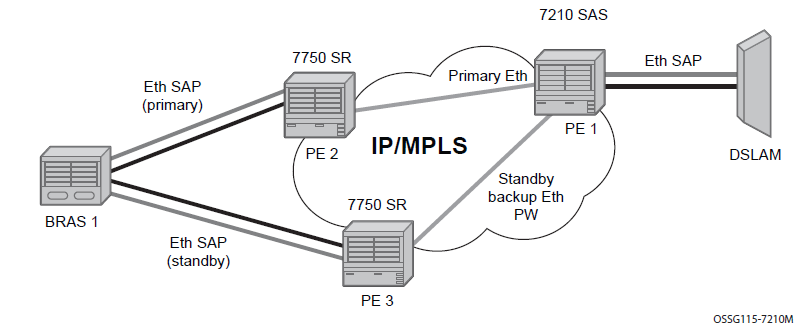The following figure shows the application of pseudowire redundancy to provide Ethernet VLL service resilience for broadband service subscribers accessing the broadband service on the service provider BRAS.

If the Ethernet SAP on PE2 fails, PE2 notifies PE1 of the failure by either withdrawing the primary pseudowire label it advertised or by sending a pseudowire status notification with the code set to indicate a SAP defect. PE1 receives it and immediately switches its local SAP to forward over the secondary standby spoke-SDP. To avoid black holing of in-flight packets during the switching of the path, PE1 accepts packets received from PE2 on the primary pseudowire while transmitting over the backup pseudowire.
When the SAP at PE2 is restored, PE2 updates the new status of the SAP by sending a new label mapping message for the same pseudowire FEC or by sending pseudowire status notification message indicating that the SAP is back up. PE1 then starts a timer and reverts to the primary at the expiry of the timer. By default, the timer is set to 0, which means PE1 reverts immediately. A special value of the timer (infinity) means that PE1 should never revert to the primary pseudowire.
The behavior of the pseudowire redundancy feature is the same if PE1 detects or is notified of a network failure that brought the spoke-SDP operational status to DOWN. The following are the events which cause PE1 to trigger a switchover to the secondary standby pseudowire:
T-LDP peer (remote PE) node withdrew the pseudowire label.
T-LDP peer signaled a FEC status indicating a pseudowire failure or a remote SAP failure.
T-LDP session to peer node times out.
SDP binding and VLL service went down as a result of network failure condition such as the SDP to peer node going operationally down.
The Nokia routers support the ability to configure multiple secondary standby pseudowire paths. For example, PE1 uses the value of the user configurable precedence parameter associated with each spoke-SDP to select the next available pseudowire path after the failure of the current active pseudowire (whether it is the primary or one of the secondary pseudowires). The revertive operation always switches the path of the VLL back to the primary pseudowire though. There is no revertive operation between secondary paths meaning that the path of the VLL does not switch back to a secondary pseudowire of higher precedence when the latter comes back up again.
The Nokia routers support the ability for a user-initiated manual switchover of the VLL path to the primary or any of the secondary be supported to divert user traffic in case of a planned outage such as in node upgrade procedures.